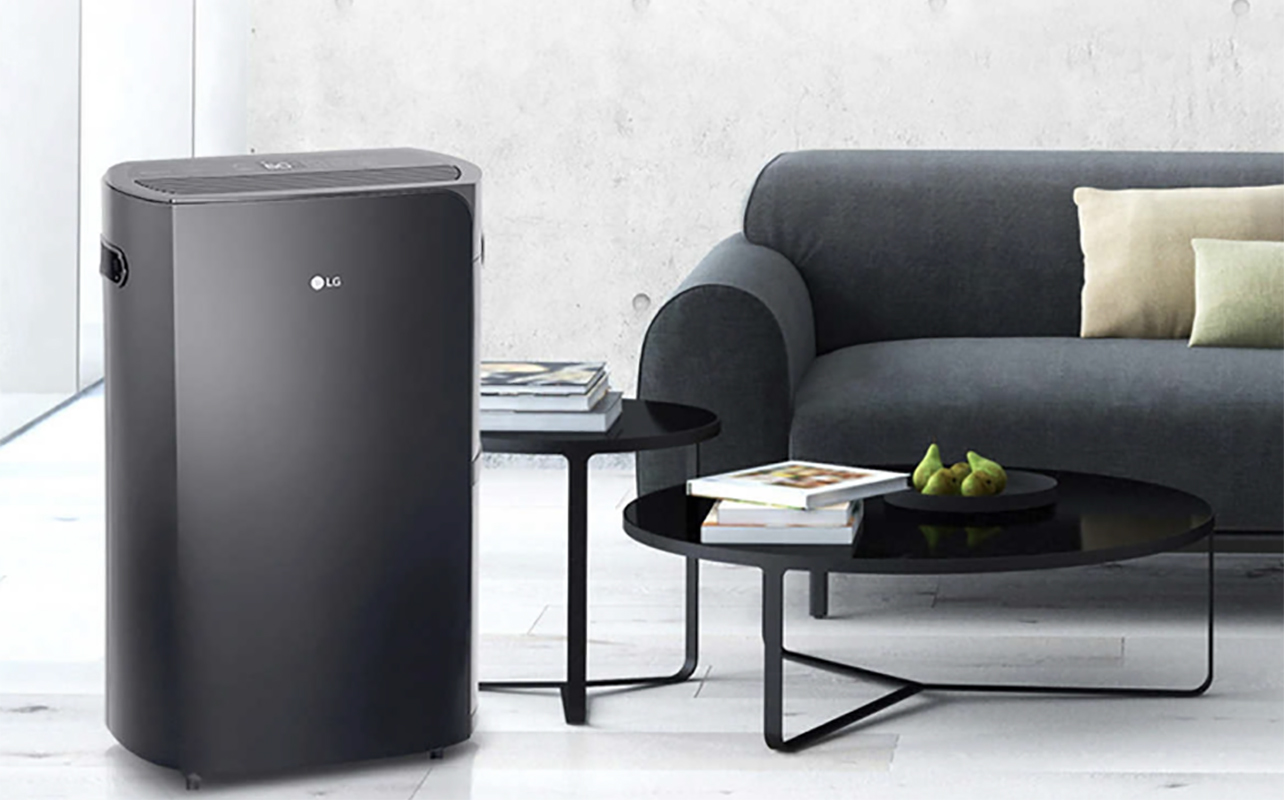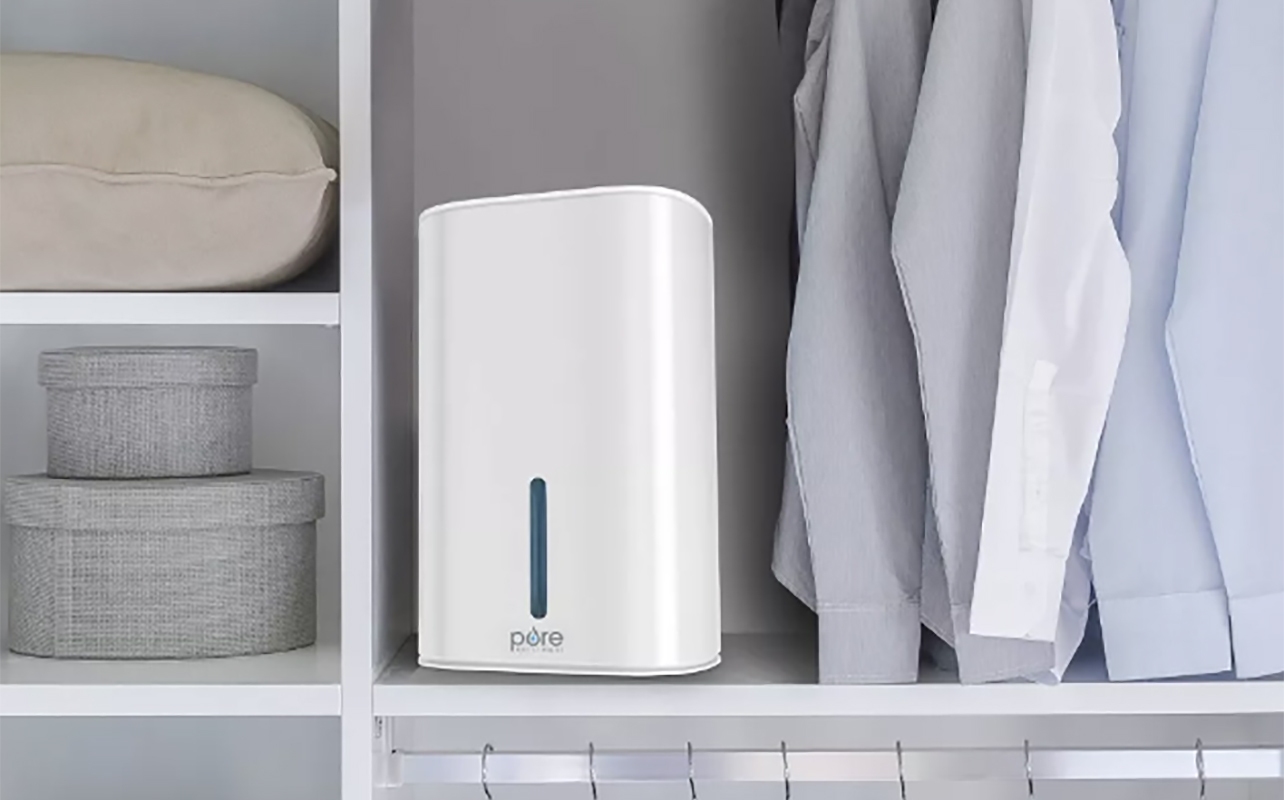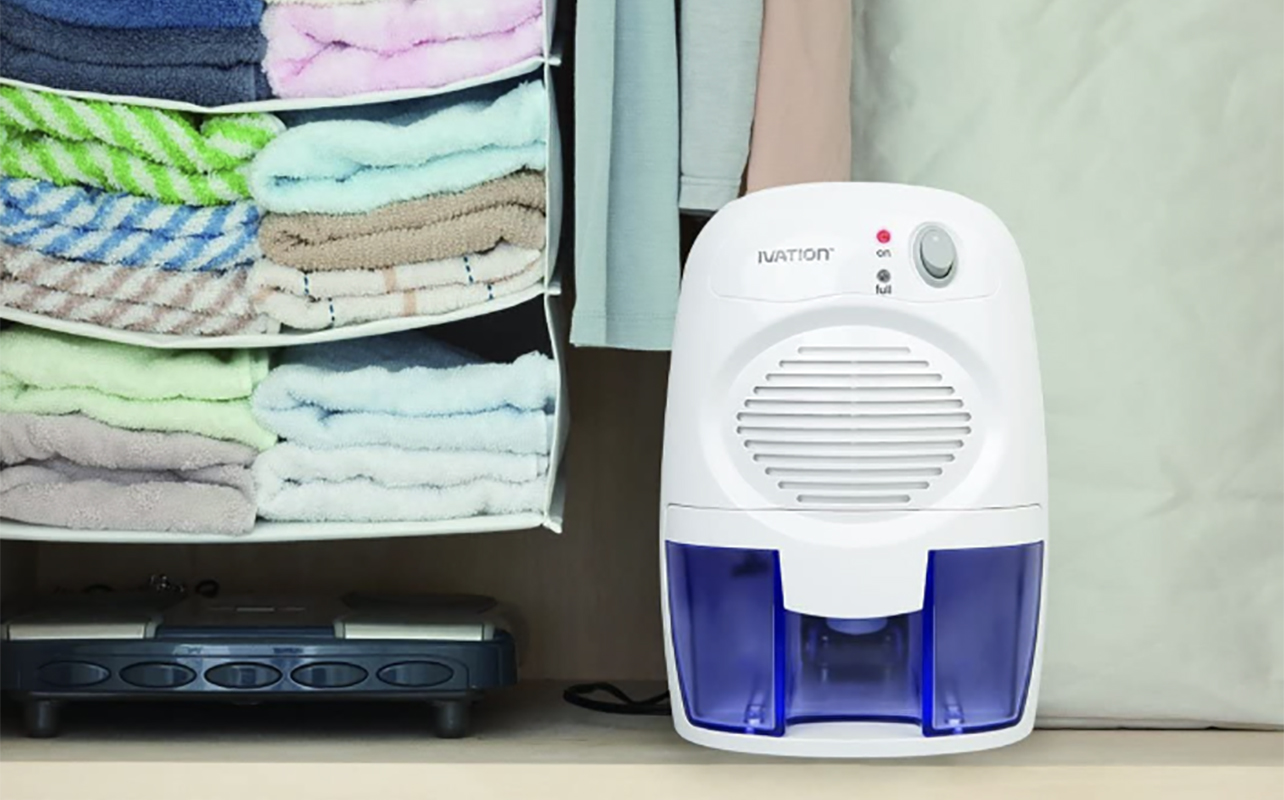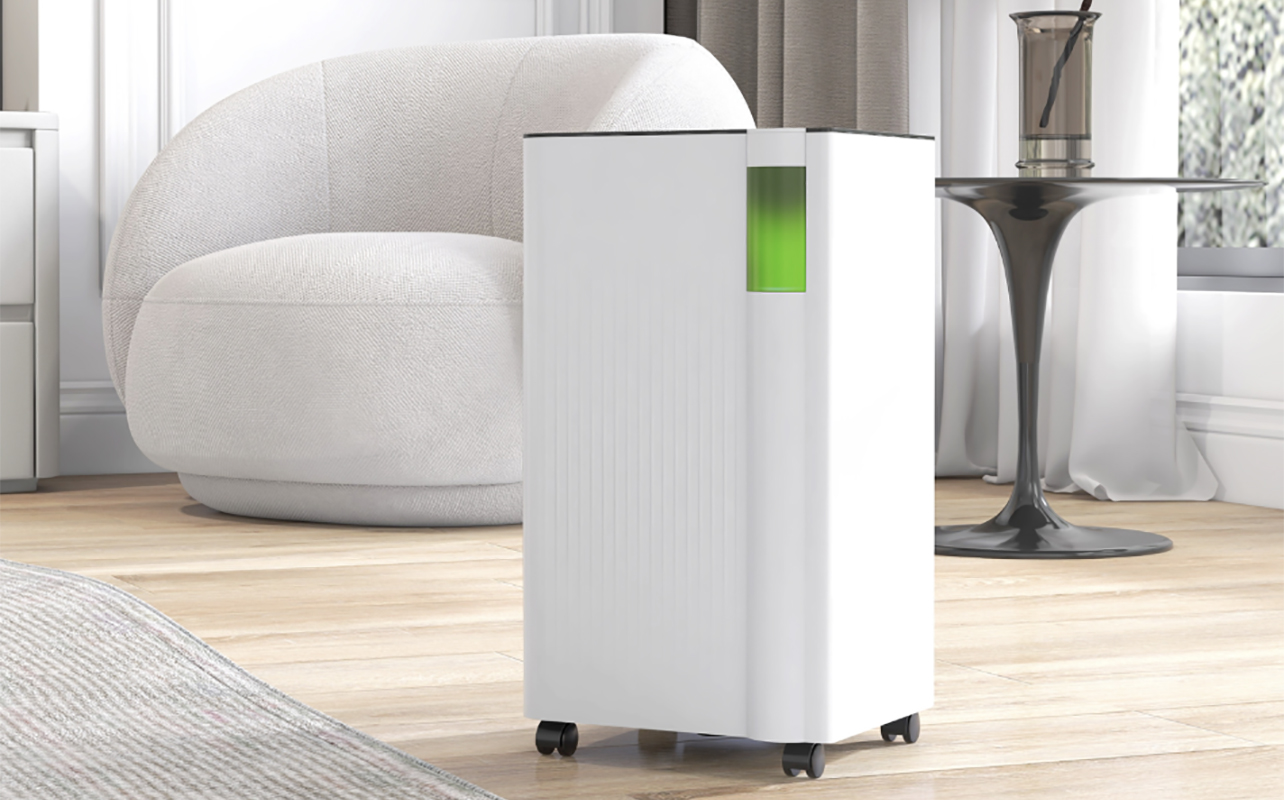
Humidity in the home is one of those issues that often creeps in unnoticed. You may feel a bit of dampness in the air, notice a musty smell in the basement, or see your windows fogging up regularly. While these may seem like minor annoyances, they can signal a bigger problem: excess moisture, which can lead to mould, structural damage, and health problems. This is where a dehumidifier comes into play.
Whether you’re looking to improve indoor air quality, protect your belongings, or simply feel more comfortable at home, a dehumidifier can make a big difference. In this guide, we’ll explore what dehumidifiers do, why they matter, and how to choose the best model for your needs. This is especially if you’re shopping for the best dehumidifier for basement use or a whole house dehumidifier.
What does a dehumidifier do?

At its core, a dehumidifier removes excess moisture from the air to help maintain an ideal indoor humidity level. This is typically between 30% and 50%. It does this by pulling humid air into the unit, cooling it over condenser coils (which causes the moisture to condense into water), then collecting that water in a tank or draining it out. The dry air is then released back into the room, creating a more comfortable and healthier environment.
Many modern dehumidifiers come with built-in humidistats that monitor the room’s humidity level and adjust their operation accordingly. This not only ensures consistent results but also helps with energy efficiency.
Why a dehumidifier matters

Excess humidity isn’t just uncomfortable, it can be damaging to both your health and the condition of your home. High humidity levels create an ideal environment for allergens, bacteria, and fungi to thrive. It can also compromise your comfort and the durability of your possessions, including wood furniture. Investing in a dehumidifier can be a game-changer, especially if you’re dealing with musty odours, damp basements, or recurring respiratory discomfort.
Prevents mould and mildew
Damp areas are a perfect breeding ground for mould and mildew, which can spread invisibly through walls, ceilings, and even insulation. These fungi can cause structural damage over time and pose serious health risks, especially for people with asthma or compromised immune systems. A good dehumidifier helps by removing the moisture mould needs to grow, especially in moisture-prone areas like bathrooms and basements.
Reduces allergens
Excess humidity significantly increases the concentration of airborne allergens, including dust mites, mould spores, and mildew. For allergy sufferers or anyone sensitive to indoor air quality, this can worsen symptoms such as sneezing, itchy eyes, and breathing difficulties. A dehumidifier and air purifier combo not only reduces humidity but also actively filters out particles. This, in turn, makes the indoor environment safer and more comfortable, particularly in high-risk zones like the basement.
Protects your belongings
Humidity can silently ruin valuable possessions over time. Wood furniture may swell and crack, electronics can corrode, books can warp, and clothes stored in closets can develop a musty odour. Wallpaper might peel, and paint may bubble or flake. A well-maintained humidity level preserves the integrity and lifespan of your belongings, from antique furniture to family photo albums.
Improves comfort
High humidity can make rooms feel stuffy, sticky, and warmer than they actually are. It often leads to poor sleep and discomfort, especially during summer months. Running a dehumidifier helps maintain a more comfortable indoor climate by lowering humidity, making the air feel cooler and lighter. It can also reduce the strain on your air conditioning system, resulting in energy savings over time.
Types of dehumidifiers

Choosing the right dehumidifier starts with understanding the different types available and which one suits your specific needs and home environment. Not all dehumidifiers are created equal. Some are better for large, open spaces, while others work best in small, enclosed rooms or cool, unheated environments. Here’s a breakdown of the main types of dehumidifiers, who they’re ideal for, and what makes each type unique.
Portable dehumidifiers
These are the most common and flexible dehumidifiers found in homes. Designed to move easily between rooms, portable dehumidifiers are ideal for addressing moisture issues in specific spaces such as bedrooms, bathrooms, kitchens, or small basements. If you’re dealing with a damp basement but don’t have a whole-home HVAC system, a high-capacity portable model can be an excellent choice.
For homeowners or renters in apartments, a portable unit offers the right mix of effectiveness and convenience. Many models now include wheels, digital displays, and automatic shut-off when the tank is full. This makes them user-friendly and low maintenance. They’re also a cost-effective solution for those not ready to invest in whole-house solutions.
Whole-house dehumidifiers
A whole-house dehumidifier is integrated into your existing HVAC system to control humidity throughout your entire living space. These systems are perfect for large homes or households in humid climates, especially if you’re noticing moisture issues in multiple rooms. Because they’re built into your home’s central air system, they operate quietly and efficiently without needing to be moved or emptied manually.
This type is best for homeowners who want hands-free, consistent humidity control across all levels of their home. They come with a higher upfront cost and require professional installation. But they offer significant energy savings and convenience over time, especially compared to running multiple portable units.
Desiccant dehumidifiers
Desiccant dehumidifiers work differently from traditional compressor-based models. Instead of using refrigerant coils, they rely on moisture-absorbing materials (like silica gel) to extract water from the air. Because of this, they’re less affected by temperature and are especially effective in cooler environments where compressor dehumidifiers may struggle.
These units are quieter, lighter, and generally more compact. They’re ideal for use in garages, unheated basements, RVs, and other small or cool spaces where conventional models aren’t as efficient. For users who need a low-maintenance, efficient option for occasional use in seasonal homes or detached structures, desiccant units offer a compelling solution.
What to look for in a dehumidifier

With so many models on the market, knowing what features to prioritize can help you narrow down your search and find a unit that fits your home and lifestyle.
Capacity
A dehumidifier’s capacity is measured by how much moisture it can remove in a 24-hour period. Choosing the right size depends on the room’s square footage and humidity level.
- Small units (20–30 pints per day) are ideal for compact areas like bedrooms, small offices, or closets.
- Medium units (30–50 pints) suit kitchens, living rooms, or moderately damp basements.
- Large units (50–70 pints or more) are best for high-humidity spaces like basements, laundry rooms, or large open areas. If you’re unsure, it’s usually better to go slightly higher in capacity to ensure effective moisture removal.
Energy efficiency
Running a dehumidifier daily can affect your energy bill, so it’s wise to choose an ENERGY STAR-certified model. These units are designed to use less electricity without sacrificing performance. Over time, the savings on utility costs can add up significantly, especially if you’re using your dehumidifier year-round or in a large space.
Tank size and drainage options
Consider how you’ll be emptying the water the dehumidifier collects. Manual tanks need to be emptied every time they fill, which can be inconvenient in very humid areas. Models with continuous drainage allow you to connect a hose that leads directly to a drain or sink, which is perfect for basements or rooms you don’t visit often. Some units also feature automatic shut-off functions when the tank is full, helping to prevent overflow.
Smart features
Modern dehumidifiers often come equipped with convenient features that make them easier to use and more efficient.
- Built-in humidistats let the unit automatically maintain your desired humidity level.
- Digital displays make monitoring easier.
- Wi-Fi connectivity and app control allow you to adjust settings remotely, ideal for those who travel, manage vacation homes, or work long hours away from home.
- Timers and programmable settings can reduce energy use by running the dehumidifier only when it’s most needed.
Thinking through how you’ll use the dehumidifier day to day, including if you want to set it and forget it or manage settings remotely, can help you prioritize which features are most important for your household.
Signs you might need a dehumidifier

Not sure if you need a dehumidifier? There are several signs, some subtle, others more obvious, that indicate excess moisture in your home. Recognizing these early can help you take action before the issue leads to more serious problems like mould or structural damage.
Condensation on windows
If you frequently see fog or water droplets forming on your windows, especially in the mornings, that’s a red flag. This kind of condensation happens when warm, moist indoor air hits the cooler surface of the glass. It’s one of the most visible signs that humidity levels in your home may be too high.
Musty or damp odours
A persistent musty smell, often strongest in basements, laundry rooms, or closets, can signal that mould or mildew is already present or starting to form. Even if you can’t see any visible growth yet, that odour is a warning sign that your air may be holding too much moisture.
Visible mould and mildew
If you spot black, green, or white specks on walls, ceilings, window frames, or around vents, it’s time to act. These are signs of active mould growth and point to long-term moisture problems. Mould not only damages surfaces but can also have serious health effects.
Damage to surfaces and materials
Excess humidity doesn’t just impact air quality, it also affects the physical structure of your home. Paint may peel, wood furniture or flooring can warp, and wallpaper may bubble or separate from the wall. These signs are often mistaken for normal wear and tear but can actually be caused by high indoor moisture.
Respiratory or allergy symptoms
If you or your family members experience more frequent sneezing, coughing, congestion, or asthma flare-ups while indoors, humidity could be a contributing factor. High moisture levels promote the growth of allergens like dust mites and mould spores. A good dehumidifier and air purifier combination can help ease these symptoms significantly.
Water stains or discoloration
Yellow or brown stains on walls or ceilings may indicate water seepage or prolonged condensation. Over time, this can lead to mould development inside walls where it’s hard to detect.
Condensation or dampness in crawl spaces and basements
Basements are especially prone to humidity problems due to their location below ground. If your basement feels damp or you notice condensation on pipes or walls, you likely need a high-capacity dehumidifier specifically designed for basement use.
Increased indoor pests
Excess humidity can also attract unwanted guests like silverfish, cockroaches, and even termites, all of which thrive in damp environments. If you’ve noticed a spike in pest activity, moisture may be the underlying issue.
By paying close attention to these warning signs and addressing them early, you can prevent costly repairs and health concerns. If more than one of these symptoms rings true for your space, it may be time to invest in a reliable dehumidifier suited to your home’s size and needs.
Comparison table: choosing the right dehumidifier for your space
| Dehumidifier type | Best for | Typical capacity | Pros | Cons |
|---|---|---|---|---|
| Small dehumidifier | Bathrooms, closets, RVs | Up to 30 pints | Compact, affordable, quiet | Not suitable for large areas |
| Medium dehumidifier | Bedrooms, kitchens, living rooms | 30-50 pints | Balanced capacity and size | May need regular tank emptying |
| Best dehumidifier for basement | Basements, laundry rooms | 50-70+ pints | Powerful moisture control | Larger footprint, more expensive |
| Whole house dehumidifier | Entire home | Integrated system | Seamless humidity control | Higher upfront cost, installation |
| Desiccant dehumidifier | Garages, cold environments | Varies | Quiet, works well in low temps | Slower moisture removal |
Final thoughts

A dehumidifier is one of the most practical appliances you can own, especially if you live in a humid climate or have a home with moisture-prone areas like basements or bathrooms. Whether you opt for a small dehumidifier for a single room, a good dehumidifier for basement dampness, or a whole house dehumidifier for complete climate control, the benefits are undeniable.
From reducing allergens to protecting your home and improving everyday comfort, a dehumidifier pays off in both short-term relief and long-term protection. If you’re still unsure which model is best for you, consider speaking with a home appliance expert or browsing by room size and features on BestBuy.ca.
A healthier, drier, and more comfortable home is just one purchase away. Check out a wide selection of dehumidifiers at Best Buy Canada.
This article was drafted using AI technology and then reviewed, fact-checked, and revised by a member of our editorial team.





